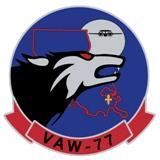
The Northrop Grumman E-2 Hawkeye is an American all-weather, carrier-capable tactical airborne early warning (AEW) aircraft. This twin-turboprop aircraft was designed and developed during the late 1950s and early 1960s by the Grumman Aircraft Company for the United States Navy as a replacement for the earlier, piston-engined E-1 Tracer, which was rapidly becoming obsolete. The aircraft's performance has been upgraded with the E-2B and E-2C versions, where most of the changes were made to the radar and radio communications due to advances in electronic integrated circuits and other electronics. The fourth major version of the Hawkeye is the E-2D, which first flew in 2007. The E-2 was the first aircraft designed specifically for AEW, as opposed to a modification of an existing airframe, such as the Boeing E-3 Sentry. Variants of the Hawkeye have been in continuous production since 1960, giving it the longest production run of any carrier-based aircraft.
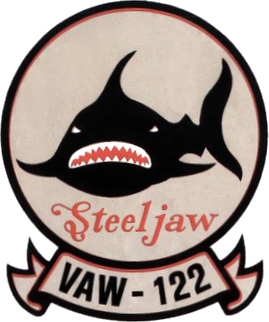
Carrier Airborne Early Warning Squadron 122 (VAW-122) was an aviation unit of the United States Navy in service from 1 September 1967 to 31 March 1996. Originally nicknamed the "Hummer Gators" and later as "Steeljaws" was a U.S. Atlantic Coast Carrier Airborne Early Warning Squadron stationed at NAS Norfolk. During its 30 years of existence, the squadron was deployed around the world and saw action from Vietnam to Desert Storm, conducting operations from the Arctic to the tropics.

Carrier Airborne Early Warning Squadron 121 (VAW-121), also known as the "Bluetails", is an Airborne Early Warning (AEW) and Command and control (C2) squadron of the United States Navy, operating the E-2D Hawkeye. Established in 1967, the squadron is based at NAS Norfolk. It is currently assigned to Carrier Air Wing 7 and deploys aboard the aircraft carrier USS George H.W. Bush.

The Tactical Support Wing (TSW) is one of three reserve aircraft wings of the United States Navy. The wing reports to the Commander, Naval Air Force Reserve. It is headquartered at Naval Air Station Joint Reserve Base Fort Worth, Texas along with the reserve's Fleet Logistics Support Wing (FLSW). The third reserve wing is the Maritime Support Wing (MSW) which is headquartered at Naval Air Station North Island, California. The wing's primary mission is operational and training support for active forces. It is composed of five flying squadrons.
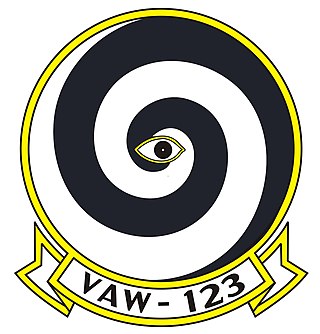
Airborne Command and Control Squadron 123 (VAW-123) is based at Naval Station Norfolk, flying the E-2C Hawkeye. They are attached to Carrier Air Wing Three (CVW-3) while deployed aboard USS Dwight D. Eisenhower. The squadron nickname is the Screwtops.

Airborne Command & Control Squadron 116 (VAW-116) is a US Navy Command and Control Squadron that deploys aboard USS Nimitz as part of Carrier Air Wing Seventeen, flying the E-2C Hawkeye 2000 aircraft. VAW-116 is stationed at Naval Base Ventura County under the cognizance of Commander, Airborne Command Control and Logistics Wing (COMACCLOGWING). The current commanding officer is Commander Phillip J. Sheridan.

Airborne Command & Control Squadron 117 (VAW-117) is an airborne early warning (AEW) and command and control (C2) squadron. Nicknamed "The Wallbangers,” it flies the E-2D Hawkeye, the only carrier-capable command and control aircraft. The squadron is based in NAS Point Mugu and deploys as part of Carrier Air Wing 9 (CVW-9) on board USS Abraham Lincoln.

Airborne Command & Control Squadron 113 (VAW-113), known as "Black Eagles", was established on 20 April 1967 flying the E-2A Hawkeye.

Airborne Command & Control Squadron 125 (VAW-125), known as the "Torch Bearers" or "Tigertails", was established on 1 October 1968, at Naval Air Station Norfolk. The squadron's initial supporting command was Carrier Air Wing Three (CVW-3) deploying aboard USS Saratoga.

Naval Air Station Joint Reserve Base New Orleans is a base of the United States military located in Belle Chasse, unincorporated Plaquemines Parish, Louisiana, United States. NAS JRB New Orleans is home to a Navy Reserve aggressor squadron and a fleet logistics support squadron, the 159th Fighter Wing of the Louisiana Air National Guard, Coast Guard Air Station New Orleans, a detachment of a Marine Corps Reserve light helicopter attack squadron, as well as other US Navy and US Army activities. The base has a 24/7 operating schedule to support both the 159 FW's NORAD air sovereignty/homeland defense requirements and for Coast Guard Air Station New Orleans search and rescue/maritime law enforcement/port security missions. It contains a military airport known as Alvin Callender Field which is located three nautical miles (6 km) south of the central business district of New Orleans. The base's predecessor, NAS New Orleans, occupied the current location of the University of New Orleans's principal campus until 1957.

Airborne Command and Control Squadron 115 (VAW-115), also known as the "Liberty Bells", is a United States Navy airborne early warning and control squadron that flies the E-2D Advanced Hawkeye. All VAW-squadrons were originally since 1948.
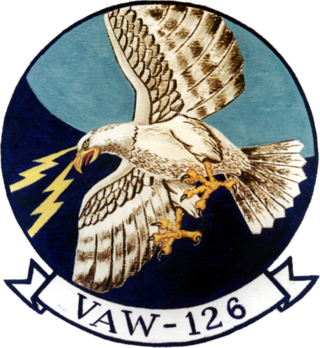
Carrier Airborne Early Warning Squadron 126 (VAW-126), nicknamed the "Seahawks", is a carrier airborne early warning squadron of the United States Navy. The squadron is based at NS Norfolk, equipped with five E-2D Hawkeye aircraft.

Carrier Airborne Early Warning Squadron 112 (VAW-112) is an inactive United States Navy squadron. It was nicknamed the "Golden Hawks". VAW-112 flew the E-2C Hawkeye out of NAS Point Mugu and last deployed in 2013 as part of Carrier Air Wing 9 (CVW-9) on board USS John C. Stennis.
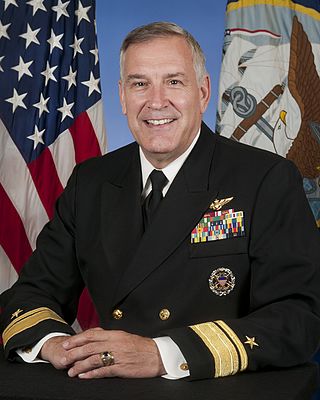
Scott Eugene Sanders received his commission in May 1980 from the United States Naval Academy and was designated a naval aviator in 1982. After completing training in the E-2C, he reported to the Seahawks of Carrier Airborne Early Warning Squadron (VAW) 126. While at VAW-126, he made deployments to the Mediterranean and Caribbean aboard USS John F. Kennedy.

Airborne Command & Control Squadron 120 (VAW-120) is a United States Navy Fleet Replacement Squadron responsible for training crews on the E-2 Hawkeye and the C-2A(R) Greyhound.

Airborne Command & Control Squadron 124 (VAW-124) "Bear Aces" is a United States Navy airborne early warning and control squadron based at Naval Air Station Norfolk, Norfolk, Virginia. It flies the Northrop Grumman E-2D Hawkeye and is currently attached to Carrier Air Wing 8 (CVW-8).

Carrier Airborne Early Warning Squadron 78 (VAW-78), nicknamed the "Fighting Escargots" or "Slugs" was a reserve Carrier Airborne Early Warning Squadron of the U.S. Navy. It was established on 1 July 1970 as part of a major reorganization of the Naval Air Reserve and deactivated on 31 March 2005.
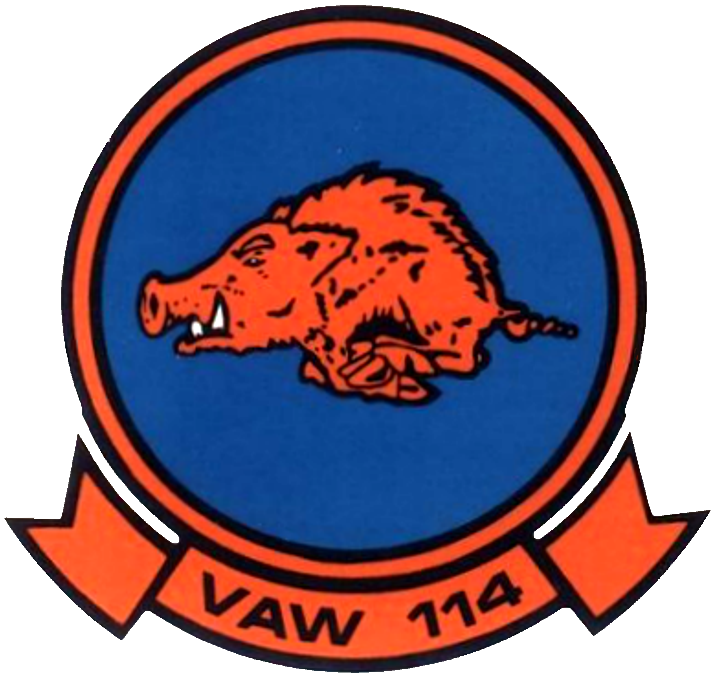
Carrier Airborne Early Warning Squadron 114 (VAW-114), nicknamed the "Hormel Hawgs". It was established on 20 April 1967, based out of NAS North Island, at which time it was already flying missions over the Tonkin Gulf in Vietnam. The squadron was disestablished on 31 March 1995 while attached to NAS Miramar.

Carrier Airborne Early Warning Squadron 110 (VAW-110), nicknamed the "Firebirds", was an aviation unit of the United States Navy based at NAS Miramar.The Firebirds were a training squadron for the E-2 Hawkeyes. It was disestablished in September 1994.
